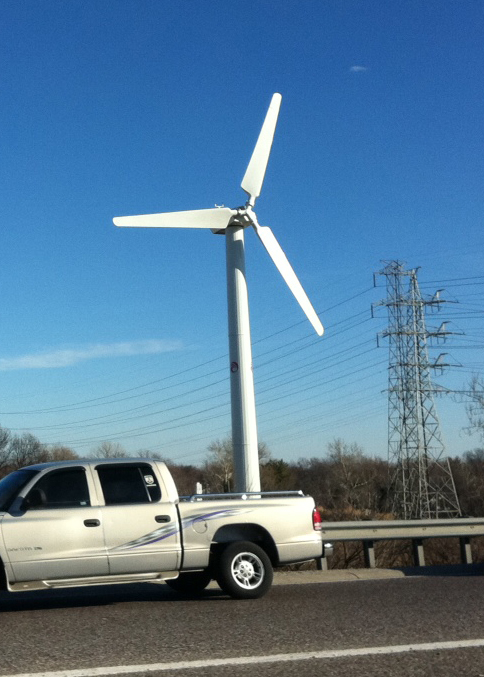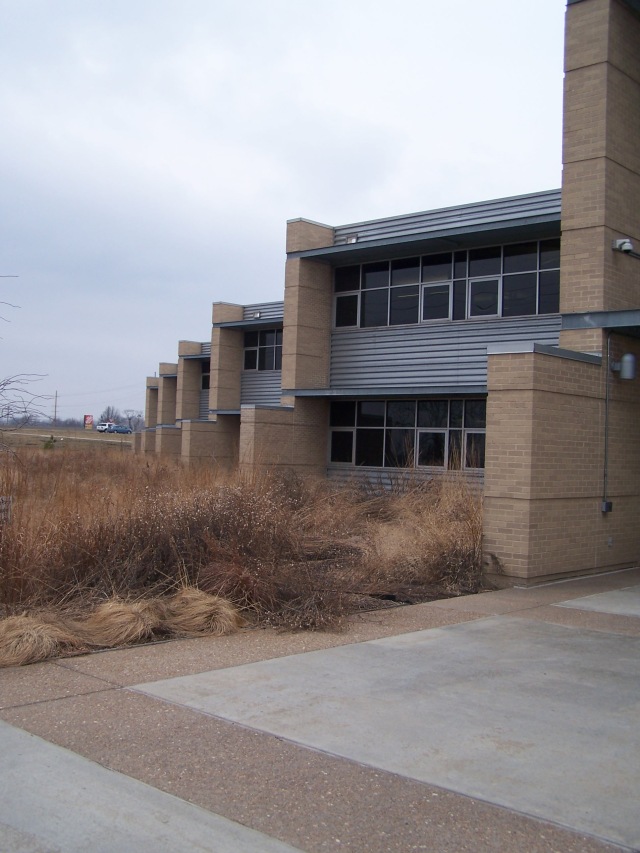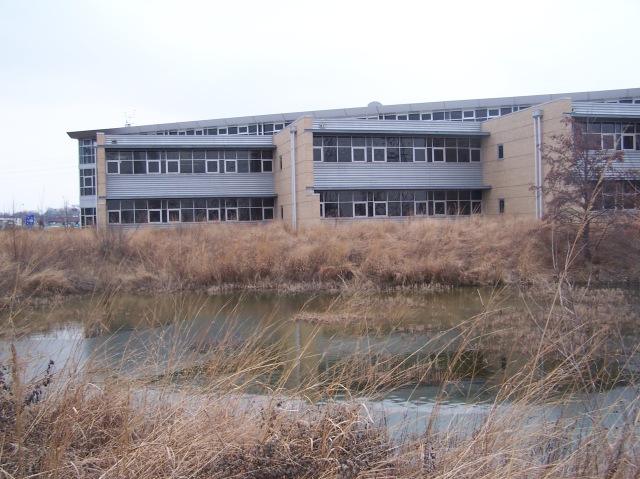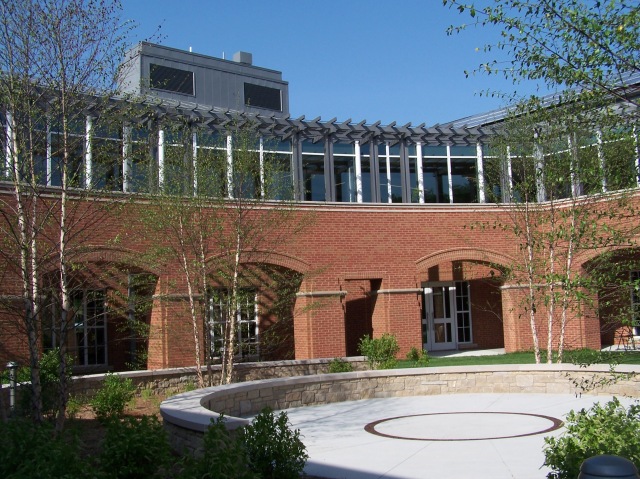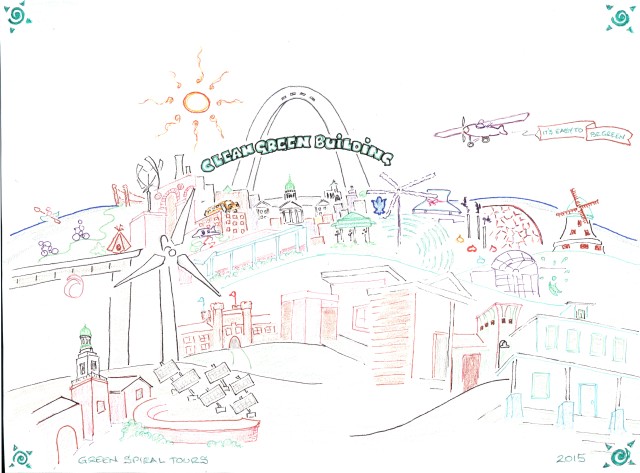Many people are surprised to learn that Saint Louis is home to some of the greenest buildings in the world. This post gives you an overview of the most interesting green buildings in Saint Louis, as well as details about how to see some of these buildings for yourself.
In 2004, Alberici Construction transformed a “brownfield” manufacturing site into a gleaming new headquarters and the greenest building in the world.
You can see their gigantic windmill (turbine) from I70, at Page Avenue, spinning merrily in the wind as a testament to their boldness and lasting achievement. The turbine replaced a billboard, and currently provides about 10 – 15% of the energy for the building.
The Alberici building is a Platinum building, the highest rating achievable on the LEED scale; it became the greenest building in the world upon completion, and over ten years later, it still stands as one of the greenest and most beautiful buildings in the world.
LEED is a rating system created by the United States Green Building Council (USGBC), a voluntary group of building professionals who came together in 1998 to challenge themselves to higher standards of rigor and scrutiny.
Arguably, no other organization has done more to move the green movement forward than the USGBC, and think about this: it’s been done largely without money or politics, and almost entirely through goodwill and self rigor. How refreshing!
Here’s a link to the U.S. Green Building Council – Missouri Gateway Chapter; know that our chapter here in Saint Louis is particularly robust.
Homework ===> Where might you find a small group of like-minded others, who are willing to challenge themselves by measurable standards, and then compete with each other for the greater good?
To tour Alberici, call and ask about the public tours at 2 pm every first Wednesday of the month, OR schedule your own group tour by calling 733-2000 x32430.

When you go, pay careful attention to the way the building orients towards the sun, notice how the air moves inside the building, and find the two different buttons on the toilets. (Toilets are always surprisingly popular features on green building tours, and often saved for the end of the tour).
Be sure to go outside and check out the short nature trail, as well as the natural landscaping around the retention pond. The turbine is surprisingly big, and makes a surprisingly amount of noise!
Here’s the best information I’ve found about the building online so far: Alberici Platinum Building Brochure
Just as great performers need great audiences, there would be no great green buildings without great clients; hats off to John Alberici and all clients who have such vision and reach.
Incidentally, the design architect for the project was John C. Guenther, FAIA, LEED AP, of Mackey Mitchell, and the project cost no more than standard construction costs. How is this possible? Two words: teamwork and creativity.
Because of it’s general beauty, excellence, staying power and predictable tour schedule, the Alberici building is a good first stop on your green building tour journey.
Next stop: Schools.
At the time of this update, in January 2015, eleven schools in the Saint Louis region have a LEED rating. Two are of special note:
The first Platinum School to be built in the Heartland makes it’s home here in Saint Louis – Crossroads College Preparatory School, located in the Central West End.
Renovated with a large addition in 2008, Crossroads College Prep is cheerful and bright and full of the sounds of busy students.
It is quickly becoming the standard for new school construction to achieve some level of LEED rating, which is based on the Olympic medal metaphor. Crossroads College Prep School stands out as a first mover, building a Platinum building many years ago.
Schools are busy places, and scheduling makes it difficult to visit green school buildings; fortunately, Crossroads College Prep graciously offers individualized tours which can be organized by contacting Development Director Heather Lake at heather@crossroadscollegeprep.org.

Here’s a link worth checking out: Crossroads College Preparatory School Goes Green
When you go, pay particular attention to the effects of daylighting on children, outdoor surfaces underfoot, indoor surfaces for noise reduction, and how sustainability is infused into the school culture and curriculum. Children require additional care and consideration in almost all things, including buildings.
As an addendum to this writing, MICDS opened their new STEM building and auditorium in 2014 to a Platinum rating. The new buildings, classrooms and outdoor study areas are spectacularly beautiful. If anyone would like to request or join a field trip to see the new MICDS buildings, Green Spiral Tours would be delighted to make the necessary arrangements.
It’s important to see best practices and build a depth of understanding from the start of the planning process, rather than tagging LEED certification on as an afterthought; we are lucky to have two fine examples of exceptionally green schools right here in Saint Louis and I urge you to take advantage of every opportunity to visit either of these fine schools.

When you go, bring your school principal, your school board members and as many people with you as you can, always keeping in mind this handy African proverb:
“If you want to go fast, take a few people with you.
If you want to go far, take everyone with you.”
Once you see these clean bright beautiful buildings, you will want one for your children, and for all children too. Green building is a step towards making this world worthy of it’s children.
Now let’s explore the greenest building in the world: The Living Building, located near Eureka and built by Washington University in 2010 as a working lab and learning center.
The Tyson Living Learning Center has met the “Living Building” challenge, and is one of only three buildings in the world to do so at the time of this writing in 2013.

A Living Building must meet criteria far more stringent than the LEED challenge; basically, a Living Building is one that approaches true sustainability, and transforms the “building as machine” metaphor into one that sees buildings as living habitats.
Living Buildings harvest, purify and use their own rainwater, create their own energy and recycle all waste; they create no pollution whatsoever. The process is as important as the product, and the effect is pleasing and authentic. The workrooms include lots of day-lighting, and the flooring is crafted from trees harvested on property. Again, the composting toilets are clean, efficient and odorless, and predictably the most popular feature on the tour.
Here’s a link to the Living Building web-site: Tyson Research Center
Unfortunately, the Living Building is a working biology laboratory and closed to the general public. Get on the Green Spiral “short list” for building tours, and when Green Spiral gets another invitation to visit the Living Building, you’ll get an invitation in your email box too.
As a side note, the Franciscan Sisters of Kirkwood show eco-films once a month. Here’s a link to an amusing movie about an eccentric architect who builds “Earthships” in the desert; the movie is called “Garbage Warrior”.
An “Earthship” is a home made of rammed earth, sometimes utilizing trash, like old tires or soda bottles to give the building structure. The result is a beautiful and inexpensive “hobbit house” with it’s own water supply and sewage treatment, plus solar greenhouses for growing food. It’s “design for the other 90%”, or in other words, for the majority of the world’s population — the people who can’t afford architects.
The above link is a long YouTube video. There is a lot of foul language in the movie — but it did not seem to overly offend the Franciscan Sisters. If anyone knows of an Earthship, or plans to build an Earthship in the Saint Louis area, Green Spiral families and followers would love to come see it!
Movie Link: Garbage Warrior 500,000 views
As we spiral through each winter, Green Spiral hunts for interesting buildings to tour, and in early spring 2013 two cutting-edge homes neared construction and are now interesting additions to the diversity of green buildings in the Saint Louis area.
One is the Active House in Webster and the other is the Passive House in Dogtown.
The Active House makes it’s home in Webster Groves; it is the very first Active House to be built in America. The Active House concept was developed in Denmark, probably in response to the Passive House movement. What distinguishes the Active House most is it’s attention to the health and well-being of the inhabitants, while of course bringing much care to the use of sustainable materials as well as energy efficiency.
Since people (not materials or energy) are the most valuable and expensive resource in any organization, the Active House marks an evolution towards embracing human capital as a primary philosophy of design in building. In terms of the broader green movement, people are more likely to pay up for new technologies that benefit them directly, such as health and well-being, rather than paying to protect an environment “out there”. The Active House is all about the health and well-being of the people inside the house.
This particular building, the Active House, is a private residence that blends seamlessly with it’s neighborhood, while using recycled, local and sustainable materials as much as possible. Private homes are limited for touring once they are occupied, so try to see them during construction Open Houses if you can. Above is a photo of the Active House during the Final Open House for the public in March 2013, which over 2,000 people came to visit! It’s beautiful inside, like living in a sunny spa. Interestingly, both the Active House and the Passive House are occupied by doctors and their families.
Here’s a local broadcast link that explains more about the Active House: http://www.ksdk.com/news/local/story.aspx?storyid=367584
And here’s a link to the Active House and it’s builders: Active House
Now on to take a look at the Passive House:

The Passive House, not to be confused with Passive Solar, was under construction in Dogtown at the time of this blog writing, and has now been finished and occupied by the homeowners. The Passive House is all about thermal mass and minimal energy usage.
Passive Houses have super-thick walls that help maintain a pleasant internal climate, and are designed to require no HVAC systems whatsoever, remaining entirely comfortable through cold dry winters and hot humid summers. The Passiv Haus is the building standard in Germany, it absolutely works, and that’s good news for a troubled planet; but it takes some work to get the typical American brain around the concept. This is the first Passive House to be built in Missouri.
As a side note, these newer building methods cost only 5 – 20% more than traditional building styles, with no economies of scale yet factored into play. Future energy savings easily outweigh the upfront costs, depending on the price of energy.
The Passive House orients towards the sun, to take advantage of solar gain, and windows are exactly placed, along with overhangs, to maximize sunlight while minimizing energy loss. The walls are thicker than a bank vault, and constructed of interlocking insulating forms, kind of like building a house with giant lego blocks.
Both the Active House and Passive House have rigourous peer communities supporting their work; watch out for fake green building certifications, this is called greenwashing. There is money to be made on going green; this is why it’s important to find professional peer groups to help sort through the subtleties involved. We all need each other to keep each other honest.
Our hot humid summers and cold dry winters are a challenge for green builders; that’s why Saint Louis gets picked to test cutting edge buildings. Ironically, our challenging weather becomes our greatest strength; as the Dalai Lama says, don’t be in a hurry to wish away your hardships, for they often become responsible for making you stronger, and better, in the end.
 Here’s a photo of the Passive House at the Open House in June 2013, plus three links for more information:
Here’s a photo of the Passive House at the Open House in June 2013, plus three links for more information:
A good overview of the Passive House by the Beacon:
https://www.stlbeacon.org/#!/content/31518/missouris_first_passive_house_062013?coverpage=3545
A nice look at the “lego-like” insulated forms from which the Passive House walls are built:
http://www.homenav.com/passive-house-concept/
And a link if you want to reach the builder, Butterfly Energy Works:
www.butterflyenergyworks.com/news
And now for a few random side notes as we wrap up a tour of green buildings in Saint Louis:
Saint Louis is home to the greatest number of Gold level LEED private residences in the world. Surprised? Thank the RCGA.
Novus International has one of the greenest buildings in the world, in Saint Peters, but Green Spiral has not toured it yet. Anybody wanna go?
The William A. Kerr Foundation has a super cool green building in an old bathhouse in downtown Saint Louis that is definitely worth visiting; they are champions of all things green and often sponsor interesting programs you can attend around town. Here’s the link to their programs and projects: http://wakfoundation.org/projects
Whew! Who knew that Saint Louis had such a surprising constellation of cutting-edge green buildings?
That’s why exploring your place on the planet is so important; you learn more things in one hour than you could possibly discover from hours and hours of research on the internet. Joining a learning community helps supercharge the learning; other people will ask questions you would never think to ask.
To join future building tours with Green Spiral, watch the Green Spiral newsletters in January, or get on the “short list” for building tours.
This post was updated in February 2015, when we spiraled back to the Alberici building for a tour with the design architect. Watch for future Green Spiral invitations in your email box, and as always, come on out and bring a friend!

